Integrated analysis of single-cell, spatial and bulk RNA-sequencing identifies a cell-death signature for predicting the outcomes of head and neck cancer
- PMID: 39575251
- PMCID: PMC11578999
- DOI: 10.3389/fimmu.2024.1487966
Integrated analysis of single-cell, spatial and bulk RNA-sequencing identifies a cell-death signature for predicting the outcomes of head and neck cancer
Abstract
Background: Cell death plays an essential role in carcinogenesis, but its function in the recurrence and postoperative prognosis of head and neck cancer (HNC), which ranks as the 7th most common malignancy globally, remains unclear.
Methods: Data from five main subtypes of HNC related single-cell RNA sequencing (scRNA-seq) were recruited to establish a single-cell atlas, and the distribution of cell death models (CDMs) across different tissues as well as cell subtypes were analyzed. Bulk RNA-seq from the Cancer Genome Atlas Program (TCGA) dataset was subjected to a machine learning-based integrative procedure for constructing a consensus cell death-related signature risk score (CDRscore) model and validated by external data. The biofunctions including different expression analysis, immune cell infiltration, genomic mutations, enrichment analysis as well as cellchat analysis were compared between the high- and low- risk score groups categorized by this CDRscore model. Finally, samples from laryngeal squamous cell cancer (LSCC) were conducted by spatial transcriptomics (ST) to further validate the results of CDRscore model.
Results: T cells from HNC patients manifested the highest levels of cell death while HPV infection attenuates malignant cell death based on single-cell atlas. CDMs are positively correlated with the tumor-cell stemness, immune-related score and T cells are infiltrated. A CDRscore model was established based on the transcription of ten cell death prognostic genes (MRPL10, DDX19A, NDFIP1, PCMT1, HPRT1, SLC2A3, EFNB2, HK1, BTG3 and MAP2K7). It functions as an independent prognostic factor for overall survival in HNC and displays stable and powerful performance validated by GSE41613 and GSE65858 datasets. Patients in high CDRscore manifested worse overall survival, more active of epithelial mesenchymal transition, TGF-β-related pathways and hypoxia, higher transcription of T cell exhausted markers, and stronger TP53 mutation. ST from LSCC showed that spots with high-risk scores were colocalized with TGF-β and the proliferating malignant cells, additionally, the risk scores have a negative correlation with TCR signaling but positive association with LAG3 transcription.
Conclusion: The CDRscore model could be utilized as a powerful prognostic indicator for HNC.
Keywords: HNC; cell death; machine learning; risk score; spatial transcriptomics.
Copyright © 2024 Pan, Fei, Wang, Chen, Jiang, Li, Wang, Yang, Zhang and Chen.
Conflict of interest statement
The authors declare that the research was conducted in the absence of any commercial or financial relationships that could be construed as a potential conflict of interest.
Figures
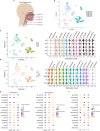
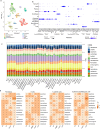
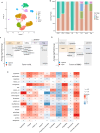


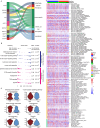
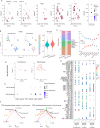
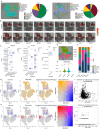
Similar articles
-
Integrated analysis of single-cell RNA-seq and bulk RNA-seq unravels the molecular feature of tumor-associated neutrophils of head and neck squamous cell carcinoma.BMC Cancer. 2025 May 1;25(1):821. doi: 10.1186/s12885-025-14179-9. BMC Cancer. 2025. PMID: 40312694 Free PMC article.
-
Establishment of an ovarian cancer exhausted CD8+T cells-related genes model by integrated analysis of scRNA-seq and bulk RNA-seq.Eur J Med Res. 2024 Jul 5;29(1):358. doi: 10.1186/s40001-024-01948-8. Eur J Med Res. 2024. PMID: 38970067 Free PMC article.
-
Joint analysis of single-cell RNA sequencing and bulk transcriptome reveals the heterogeneity of the urea cycle of astrocytes in glioblastoma.Neurobiol Dis. 2025 May;208:106835. doi: 10.1016/j.nbd.2025.106835. Epub 2025 Feb 10. Neurobiol Dis. 2025. PMID: 39938577
-
Tumor Mutation Burden, Immune Cell Infiltration, and Construction of Immune-Related Genes Prognostic Model in Head and Neck Cancer.Int J Med Sci. 2021 Jan 1;18(1):226-238. doi: 10.7150/ijms.51064. eCollection 2021. Int J Med Sci. 2021. PMID: 33390791 Free PMC article.
-
Heterogeneity of the tumor immune cell microenvironment revealed by single-cell sequencing in head and neck cancer.Crit Rev Oncol Hematol. 2025 May;209:104677. doi: 10.1016/j.critrevonc.2025.104677. Epub 2025 Feb 27. Crit Rev Oncol Hematol. 2025. PMID: 40023465 Review.
Cited by
-
A comprehensive characterization of metabolic signatures-hypoxia, glycolysis, and lactylation-in non-healing diabetic foot ulcers.Front Mol Biosci. 2025 Jul 9;12:1593390. doi: 10.3389/fmolb.2025.1593390. eCollection 2025. Front Mol Biosci. 2025. PMID: 40703704 Free PMC article.
References
MeSH terms
Substances
LinkOut - more resources
Full Text Sources
Medical
Research Materials
Miscellaneous

